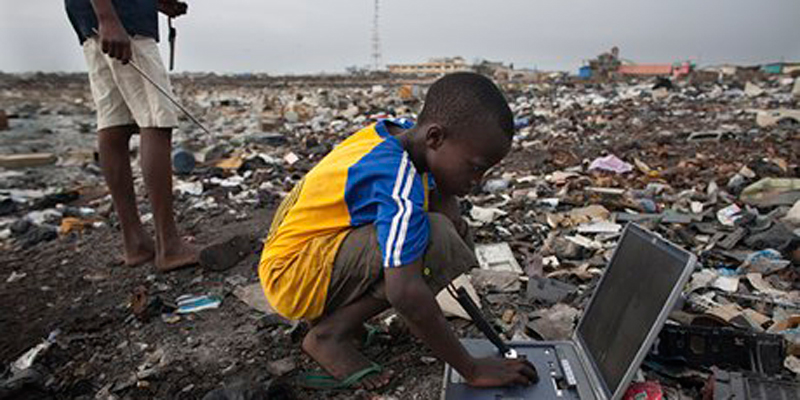
As the lifetime of electronic products shortens, gadgets are being replaced much faster than ever before.
BY CHIPO MASARA
In the developed world, lifespan of a cellphone is now only 18 months while that of a laptop is currently two years.

Innovations in the electronic field have certainly made life for people better in many ways, but at a great cost. It has generated a lot of e-waste!
Electronic waste, otherwise commonly known as “e-waste”, refers to “all discarded electric or electronic devices with battery power or circuitry or electric elements e.g. mobile phones, television sets, computers, printers, stereo systems, refrigerators, washing machines, driers, etc.”
According to the UN 2012 report, within five years: “the world’s electronic waste will grow by 33% from 49,7 million to 65,4 million tonnes.” China reportedly generated 11,1 million tonnes in 2012 alone, followed by the US which was at 10 million. The figures are expected to have since shot up drastically.
People in the developed world have fully embraced electronic innovation and are excited whenever big companies like Apple Inc. or Samsung launch new products. Often, older gadgets are dumped as soon as new and sleek ones are introduced. But amid all the innovation and excitement, developed nations are left with one huge problem — where to dispose of the older gadgets that they no longer need.
- 'Govt dipping fingers everywhere'
- Developing nations equally guilty of climate sins
- Developing countries accumulating more waste thereby accelerating carbon emissions
Keep Reading
But indications are that developed countries have found an open e-waste dumping ground in the form of developing countries!
The majority poor countries also need access to information technology, but cannot afford new equipment; hence there is a high demand for good quality second-hand goods. In Africa, while the Nokia 5110 caused quite a stir in the late 90s when the cellphone craze began, it has long been discarded for the ones that allow internet connectivity, with smartphones and tablets currently being the preferred mode of communication.
According to the UN report, millions of old phones, tablets, laptops, toys, digital cameras and other electronic devices from developed countries are being illegally dumped in developing countries.
The European Environment Agency estimates that between 250 000 to 1,3 million tonnes of used electrical products are being shipped out of the EU every year, mostly to West Africa and Asia.

The Waste Electronic and Electrical Equipment (WEEE) regulations restrict shipping of EU e-waste to non-OECD (i.e. developing) countries for recycling and recovery, only for reuse, but there is considerable concern about illegal exports to Africa and Asia.
While it is legal to export discarded goods to poor countries for reuse, a lot of non-functional electronic goods are reportedly being shipped to Africa and Asia under the pretext they are “used goods”.
Industry experts estimate that of the e-waste being generated in the developed world, 50-80% is being exported to developing countries.
When people in first world countries discard electronic goods, some may earnestly be expecting them to get recycled properly, but according to experts, the toxic chemicals contained in most devices make it difficult to recycle them, hence the bulk end up in landfills.
According to reports, large quantities of computers sent to Lagos, Nigeria for supposed reuse, would mostly be non-working and non-repairable. And because the country does not have e-waste recycling technology, the trash — which is laden with toxins — ends up being burnt in open pits that are close to residential areas.
Toxic elements like cadmium, lead, mercury, phosphorous penta chloride, polyvinyl chloride and beryllium among others, are often contained in e-waste and are extremely toxic to both humans and the environment. Research has also shown that e-waste pollution in the air may cause inflammation and stress, DNA damage, heart disease and cancer, among other things.
There is also a real danger of the heavy metals and toxic chemicals leaching into soils in landfills, polluting groundwater.
Meanwhile, a former wetland known as Agbogbloshie in Accra, Ghana is now home to what has become the “world’s largest e-waste dumping site” and has become known for being the “destination for legal and illegal exportation and environmental dumping of electronic waste (e-waste) from industrialised nations.”
Although e-waste may not yet be considered a major challenge in Zimbabwe, there seems to be lack of know-how about what it involves. Nevertheless, like most developing countries, Zimbabwe is determined to keep up with electronic advancements, a fact apparent through the huge amounts of electronic goods coming into the country every day.
While access to information technology for all is necessary if there is to be social and economic development in Africa, and indeed in all developing nations, experts believe stopping the generation of e-waste in developing countries will require stern measures.
Controls in the form of treaties such as the Bamako Convention and Basel Convention — set up to stop developed nations from dumping their waste in developing countries — helped create awareness in affected countries about the e-waste problem. But it seems actually stopping the ongoing dumping of e-waste will require more control measures than presently available.
Each developing country needs to have its own e-waste regulations that require all importers to register, to allow for greater scrutiny of goods they bring in.

To minimise the effect on people of e-waste dumped in their communities, countries should be empowered with the knowledge required to sustainably process e-waste. Metals from different devices can be used for many things, if extracted properly. Cellphone batteries and other metals contained in phones for instance, can be used to make either new ones, jewellery, metal plates and other electronic gadgets, among other things.










